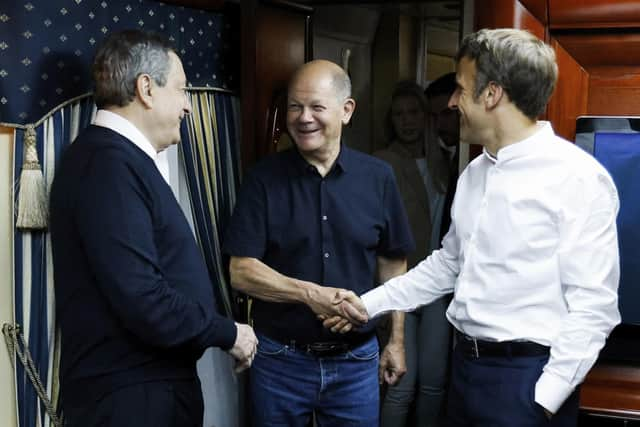Ukraine conflict: Russian forces in Donbas ad hoc and undermanned says MoD as European leaders visit Kyiv
The intelligence report from the MoD comes as leaders of France, Germany and Italy visit Kyiv today, a day before the European Commission is due to make a recommendation on Ukraine's status as an EU candidate.
Ukraine began the process of applying to join the EU in February, four days after Russia's invasion with French President Emmanuel Macron stating previously Ukraine could join a "parallel European community" while it awaited a decision.
Advertisement
Hide AdAdvertisement
Hide AdFrench President Emmanuel Macron, German Chancellor Olaf Scholz and Italian Prime Minister Mario Draghi arrived in Kyiv today to meet with Ukrainian President Volodymyr Zelensky and their continued support for the nation with Macron stating: "It's an important moment. It's a message of unity we're sending to the Ukrainians"
Last week Macron said Europe needed to reassure Ukraine over its EU ambitions stating: "We are at a point when we need to send clear political signals, us Europeans, towards Ukraine and its people when it is resisting heroically."
The conflict in Ukraine continues, with advances continuing throughout the Donbas.
The MoD said in an update that some Russian Battalion Tactical Groups, that would typically compromise 600-800 people, now only consist of about 30 soldiers, and that such small groups on foot make some advantages of Russia less relevant.
The intelligence report from the MoD also stated that destruction of all the main bridges into Severodonetsk has left Russian troops needing to find a way to get to the embattled eastern city "to turn tactical gain into operational advantage".


In a lengthy update they said: “All of the main bridges over the Siverskyy Donets River, which link the contested town of Sieverodonetsk and Ukrainian-held territory, have now highly likely been destroyed.
"Ukraine has probably managed to withdraw a large proportion of its combat troops, who were originally holding the town. The situation continues to be extremely difficult for the Ukrainian forces and civilians remaining east of the river.
"With the bridges highly likely destroyed, Russia will now likely need to either conduct a contested river crossing or advance on its currently stalled flanks to turn tactical gain into operational advantage.”
Advertisement
Hide AdAdvertisement
Hide AdIt added: “Russia’s combat force in the Donbas is highly likely operating in increasingly ad hoc and severely undermanned groupings.
"As claimed by the Ukrainian authorities, some Russian Battalion Tactical Groups (BTGs) - typically established at around 600 to 800 personnel - have been able to muster as few as 30 soldiers.
"For both sides fighting in contested towns, front line combat is likely increasingly devolving to small groups of troops typically operating on foot.
"Some of Russia’s strengths, such as its advantage in numbers of tanks, become less relevant in this environment. This is likely contributing to its continued slow rate of advance.”
Nato will also be discussing Ukraine in their meeting in Brussels today, with Sweden and Finland’s applications to join the transatlantic military alliance also likely to be on the agenda.
